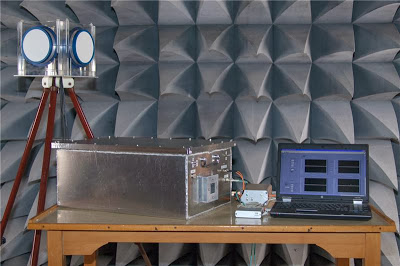

| Visitors Now: | |
| Total Visits: | |
| Total Stories: |

| Story Views | |
| Now: | |
| Last Hour: | |
| Last 24 Hours: | |
| Total: | |
Suitcase Electromagnetic Weapon Attacks And Defending Against Them
We are all familiar with the power of electromagnetic attacks from the movies: in Ocean‘s Eleven, George Clooney’s gang disables Las Vegas’ power grid, and Keanu Reeves’ henchmen hold off the enemy robot fighters from their spaceship in the Matrix Trilogy. The heroes in the films succeed by sending out a very strong electromagnetic pulse. This changes the voltage in the vicinity so that regulators, switches, and circuit boards in electronic equipment go crazy. You cannot smell, taste, or feel this radiation. Those affected by it do not know why computers or machines breakdown or from which direction the attack comes.
“What works on the silver screen is also conceivable in reality,” confirms Michael Jöster from the Fraunhofer Institute for Technological Trend Analysis INT in Euskirchen, just south of Cologne, Germany. The researchers there are concentrating on the question of how these attacks can be detected. They have developed a measurement instrument for this purpose that is capable of determining the strength, fre- quency, and direction of electromagnetic attacks. The engineering requirements are steep: the detector must measure very high field strengths from very short pulses, yet not be destroyed or damaged itself.
Identifying the type, location, and duration of the attacks
Four specialized antennas make up the INT demonstration instrument that sample the environment around the subject device to be protected. Each of these covers a quadrant of 90 degrees and detects all types of electromagnetic sources. A high-frequency module preconditions the signals for measurement and determines when the electromagnetic pulse started and stopped. A computer in a monitoring station connected via an optical conductor then calculates the values for the signal and presents them on a screen.
Tools for defending against electromagnetic attack (right to left): an antenna set (on tripod) for sensing the environment, a RF measuring device for conditioning the signals and a computer that calculates the relevant data.
Credit: © Fraunhofer INT
Electronic devices can withstand a certain amount of radiation. This is measured in volts per meter (V/m) – called the electromagnetic compatibility (EMC). Otherwise, they would not operate reliably. Every device could interfere with others in its immediate vicinity. Depending on the category of usage, they therefore have to fulfill specific EMC requirements. These are significantly higher for industrial applications than for common things like Smartphones, televisions, or stereo equipment.
Contacts and sources:
Michael Jöster
Fraunhofer Institute for Technical Trend Analysis INT
Fraunhofer-Gesellschaft
More stories
The Wildest Ride, And It’s All Electric Flight
Seven Headed Snake Rocks The World
17 Mysteries Awaiting Explanation
Newest Moon Structures Discovered, Video
Shadow Men, Ghosts And Demons: Ten Inexplicable And Creepy Photographs
Strange Spacecraft: Whose Are They
25,000 Year Old Buildings Found In Russia
13 World Mysteries Without Explanation
Grey Aliens Filmed By KGB, Russian Alien Autopsy
High Tech Power Generation Older Than The Inca Claimed in South America By Researcher
UFO Caught Over Wind Farm In Devon, England; Light Ships Seen In Mexico And By ISS
15 Modern Sea Monsters, Photos And Video
Source: http://www.ineffableisland.com/2013/12/suitcase-electromagnetic-weapon-attacks.html





By the time you detect it too late all over, All you can do later on is find out what happened,and where it came from.But by then they and the eqiptment will be long gone.
Great post, very interesting, good info, thanks…and I like your list of stories vey nice..Happy Holidays to you!